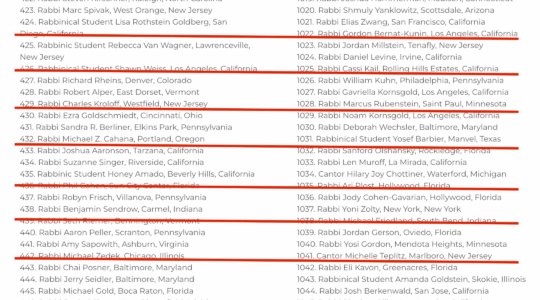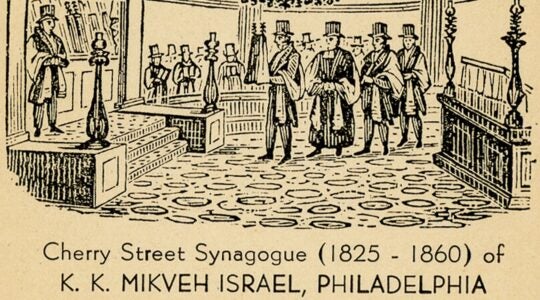For many Jews across the United States and globe, memories of last year’s Shemini Atzeret and Simchat Torah will forever revolve around grim phone alerts and hushed conversations in synagogue, tears, hugs and the dawning realization that an unfathomable number of Israelis had been killed or taken captive.
Now, those communities face the challenge of figuring out how to celebrate the same holiday one year later.
“On the one hand, it is a festival, a day when it is forbidden to give eulogies and to mourn,” Rabbi Leo Dee wrote in Britain’s Jewish Chronicle. “On the other hand, it is the anniversary of the most tragic attack against humanity since the Holocaust.”
He went on to ask questions that have occupied rabbis and Jewish leaders at synagogues worldwide: “Can we dance again? Can we celebrate again? How should we respect the victims?”
Oct. 7, 2023, and its aftermath have now shaped a full year on the Jewish calendar — prompting people to light menorahs salvaged from the wreckage of Gaza border communities, leave empty seats for the hostages at their Passover seder tables and, this week, decorate their sukkahs with motifs drawing attention to those still captive.
Simchat Torah — which marks the end of the yearly Torah-reading cycle and begins on Thursday evening — is especially vexing: Although most commemorations of the attack took place on Oct. 7, Simchat Torah is the one-year Hebrew anniversary, or yahrzeit, of the attack. That sad occasion is further complicated by the festive nature of the day, which is usually filled with dancing and singing. It is the only major Jewish holiday that has the word “joy” in its name.
“How can we celebrate when the Jewish people has lost so many hostages, soldiers, siblings, and friends, when we in Israel have sat shiva too many times?” reads a guide for this year’s Simchat Torah published by Hadar, the egalitarian Jewish educational institute. “Can we dance with Torah scrolls whose embroideries now bear, for a lasting memory, the names of our murdered loved ones?”
Synagogues and communities, in the United States, Israel and beyond, have come up with answers that they hope will do justice to the day’s inherent joy as well as its mournful mood this year.
Many congregations are focusing on the core Simchat Torah ritual of hakafot, or sets of seven circular dances around the Torah. This year, some synagogues will devote one of the seven to commemorating the day’s tragedy.
“What a lot of rabbis are talking about doing is having one of those circles be kind of staid and subdued and maybe even silenced, as opposed to singing and dancing, to mark those who were lost,” said Rabbi Mike Uram, the chief Jewish learning officer at the Jewish Federations of North America.
“There’s a huge number of Jews in North America who have deep personal and family connections to people who’ve been killed either on Oct. 7 or in the war,” Uram continued. “So there’s going to be a lot of sadness as those memories of lost loved ones and family members come back to them.”
In the Hadar guide, Renana Ravitsky Pilzer, a scholar at the Shalom Hartman Institute, suggests imbuing each of the seven hakafot with a theme — but making the first one completely silent, to provide a single space for the day’s complex and conflicting emotions.
“Let us use it to express justification or protest, shock or weeping, the inability to accept contradictions, or acceptance,” she wrote. “Let us recognize that members of our community have diverse and opposing interpretations of both the ancient and current silence, and we will share a moment of silence together.”
Another initiative will commemorate the attack using the Torah scrolls themselves. The Simchat Torah Project, launched by Mizrachi, a global Zionist organization, has created a Torah vestment that it has sold to over 500 communities across 31 countries, and which displays the Israeli flag and one of the victims of the attack.

The Torah vestment made by the Simchat Torah Project. (Courtesy)
The vestment will also feature a famous quotation from Ecclesiastes, the book read on Sukkot, days before Simchat Torah: “There is a time for everything under the Heavens… a time to mourn, and a time to dance.” Each vestment costs $1,300.
“The Jewish world will be unified, knowing that across the globe, Jews are dancing with Torah scrolls that collectively link us all with the events of October 7th, and inspire us to realize that ‘Am Yisrael Chai,’” or the Jewish people lives, the project’s website reads.
While Shemini Atzeret and Simchat Torah are observed on the same day in Israel, the festival is two days in the Diaspora, and Shemini Atzeret — which falls on the first day, when the massacre occurred — also includes a communal memorial service, known as Yizkor. Then, that night, Simchat Torah begins.
Temple Beth Sholom in Cherry Hill, New Jersey, is using that distinction to structure its commemoration of Oct. 7. Taking its cues from the transition between Israel’s Memorial and Independence Days, which are celebrated back-to-back, the synagogue will pay tribute to the victims of the attack on Shemini Atzeret, then hold a “transition ceremony” to move into the joy of Simchat Torah.
“We will make space to remember and to celebrate the strength and resilience of our people,” Rabbi Micah Peltz wrote in the synagogue bulletin.
Resilience has been a watchword for many communities as they approach Simchat Torah. Some are adopting a refrain that originated at the Nova music festival, where more than 360 people were murdered on Oct. 7, and has come to represent hope and perseverance in its aftermath: “We will dance again.”
At Sinai Temple in Los Angeles, congregants have been asked to wear blue and white — the colors of the Israeli flag — as they join for “Simchat Torah in the Streets: We Dance Again.” The event will feature a live band, singing and dancing with Torahs and an ice cream truck.
At Washington D.C.’s Sixth & I, a Simchat Torah event is billed as “Choosing Joy.” The event page notes that on the Shabbat prior to the holiday, Jews will read the same passage from the book of Ecclesiastes about “a time for dancing.”
“Last year, we grieved,” the event page reads. “This year, we’ll dance again.”
In Israel, celebrating Simchat Torah is even more fraught: Some communities are doubling down on joy, while others are forgoing celebration this year. Organizers of Ohr HaChaim synagogue in Jaffa decided that each of their hakafot would begin with soft songs that grow louder, while the seventh hakafah will be danced in silence. After hakafot, the community will come together for a communal meal that will provide space for sharing and reflection.
The synagogue’s prayer for rain, another piece of the holiday’s liturgy, will also include Kinat Be’eri, a dirge composed in memory of those killed at the border kibbutz on Oct. 7.
But not all congregants agree on the format. Nili Salem said she planned on “putting all my heart’s energy into dancing.”
“This year people feel uncomfortable with Simchat Torah, they’re wondering if they should dance. But we need to remember, It’s also their yahrzeit and that comes with tremendous light,” she said. “We don’t only dance because it’s fun and we’re happy, it’s also a spiritual endeavor. With dancing, we have the greatest chance of elevating their souls and sweetening the judgments on us.”
Oshrat Shoham, who co-founded the Kehillat Hakhel community in Jerusalem — where the family of slain hostage Hersh Goldberg-Polin belongs — suggested a handful of approaches to the holiday, including one devoid of Simchat Torah’s typical jubilance.
“There will be no celebrations, no dancing, and no hakafot — neither in the evening nor in the morning,” Shoham proposed in the Hadar guide. “We will add Psalms and prayers for the return of the hostages, for the safety of the soldiers, and for the healing of the wounded. We will expand the Yizkor prayer to include a memorial for the victims of the October 7th massacre and offer a heartfelt prayer for rain — for blessing, and not for a curse.”
Some people have suggested concrete gestures to pay tribute to the attack’s victims on the occasion of the holiday. Dee, whose wife and daughters were killed in a West Bank terror attack months before Oct. 7, suggested that Diaspora communities use the holiday to promote aliyah, or immigration to Israel.
And Daniel Loeb, the CEO of Third Point, a hedge fund that manages an estimated $14 billion in assets, partnered with Chabad, Yeshiva University, Sefaria and other Jewish organizations to launch the Simchat Torah Challenge, which aims to encourage at least 10,000 Jews to commit to reading the entire Torah, one portion a week, from this year’s holiday to next year’s. According to the project’s website, that goal has already been reached.
“The terrorists who targeted Israel last year chose to do it on the holiday of Simchat Torah, the joyous day on which we finish reading the Torah and begin anew,” Loeb told eJewishPhilanthropy. “This year, we hope to invite many more Jews into what is one of humanity’s oldest book clubs, and help them engage in learning the Torah, through one life-changing portion per week.”
Uram said that no matter how one chooses to observe Simchat Torah this year, the spirit of the holiday itself encourages Jews to reflect and grapple with the world around them.
“It’s a strange peculiarity that every single year, Jews read the same book,” Uram said, referring to the Torah. “In a world where most of us read things that are almost disposable in nature — the news and tweets and how quick media moves, you kind of read it once and it disappears — there’s this countercultural approach in Jewish tradition of reading deeply and reading over and over again.”
He added, “And the idea is that while the text may stay the same, the person who’s reading each year changes.”
JTA has documented Jewish history in real-time for over a century. Keep our journalism strong by joining us in supporting independent, award-winning reporting.






